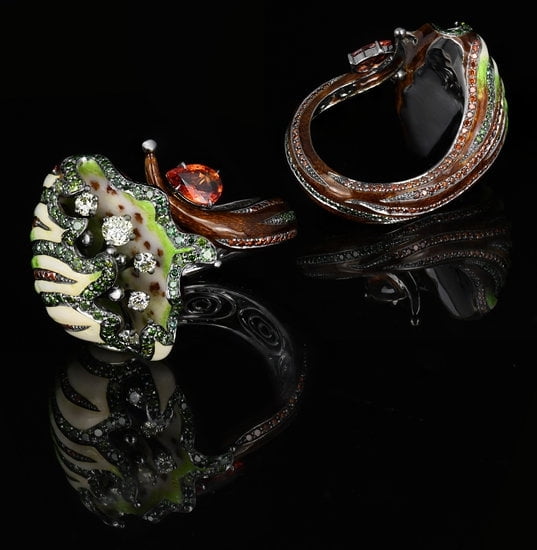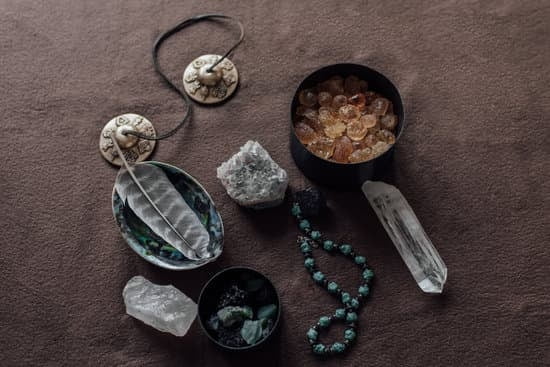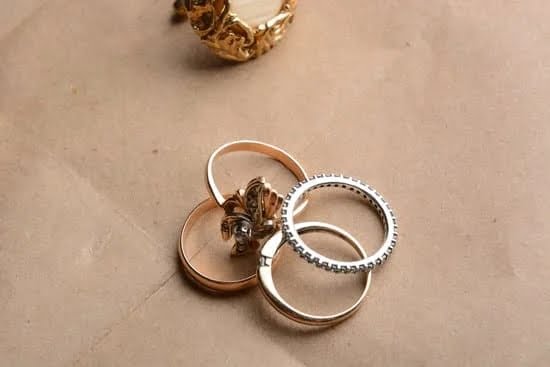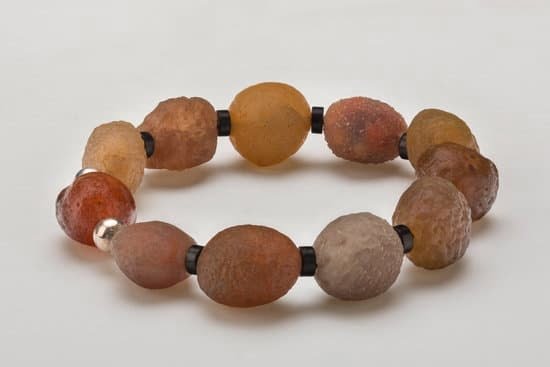Introduction
Acrylic jewelry is a popular choice for many crafters. It is lightweight, easy to work with, and available in a range of colors and textures that can create beautiful pieces. By utilizing sheets of acrylic along with other components such as findings or beads, crafters can make necklaces, rings, earrings, or even full-scale bracelets.
Acrylic is relatively inexpensive compared to traditional metals or gemstones which allows crafters to have room to experiment. Additionally, it lends itself to various shapes and can be easily formed into intricate designs. Popular techniques used when crafting acrylic jewelry include laser cutting and engraving, hand painting and staining, beadwork and stringing components together, casting with resin epoxy molds, etching paper images onto cover sheets using an X-acto knife before attaching the composition to the acrylic jewelry piece with adhesive.
With so many possibilities available for creating unique designs out of acrylics it comes as no surprise why this substance has become increasingly popular in the craft world today. Curious minds can explore examples of popular projects such as custom phone cases with embedded artwork; glowing neon earrings made by illuminating cutouts from bright laser cut acrylic pieces; custom silhouette necklaces that feature paper silhouettes adhered to colored acrylic crystals; or even 3-dimensional letterforms made of layered clear acrylic pieces. With endless options available let your creativity flow!
Tools and Materials
Making acrylic jewelry requires a few essential tools, such as: a drill with a small- to medium-sized bit (for making holes to hang hardware onto the acrylic pieces); an engraver and/or cutting tool (for shaping the acrylic pieces); sandpaper or buffing wheel (for polishing the edges); and adhesive (to attach metal parts).
Acrylic, also known as plexiglass or clear plastic, comes in several forms. Sheet form can be cut into any shape using a saw, laser cutter, jigsaw or by hand. Tubular form is available in various thicknesses, diameters and lengths. Acrylics come both tinted and clear in various colors and opacities; some are marbled or textured. Along with acrylics, other materials for decorating jewelry include metal findings and components made from precious metals (sterling silver or gold-filled) as well as glass beads and gemstones.
There are numerous online retailers selling these tools and materials for making jewelry out of acrylic; most offer discounts on orders over a certain minimum amount. In addition, there may be local art stores which stock what you need for your project; this will help reduce shipping costs. Finally, make sure that you select the highest-quality tools for your projects for maximum satisfaction with the product as well as safety when working with them.
Designing Process
The design process for making acrylic jewelry involves a few steps of planning and creating pieces that are unique. Before you get started, you’ll want to determine what type of acrylic you’d like to use, how to ensure the pieces fit together properly and the best ways to drill the holes necessary for successful jewelry-making. It is important to understand the size, shape, and characteristics of your material so that you can properly plan out your designs.
Once you’ve decided on the design and placed them onto your sheet or block of material, it’s time to begin cutting. There are many methods available from traditional saws and dies with regular workshop machinery, to laser etching machines with more detailed results. When drilling holes for connectors and attachments make sure proper measurements are taken beforehand in order for everything to fit properly in your finished piece.
Finishing touches include sanding edges smooth, polishing surfaces with cloths or even buffing wheels if desired, painting on layers of color if desired, adding extra elements such as beads or charms for extra detail, and sealing all the parts with an appropriate clear sealant. When working with various materials like acrylic, there will be slight differences in appearance depending on how much light passes through them creating beautiful effects within your final products. Always follow safety protocols when using machinery and wear protective eyewear as well as gloves while working!
Assembly
Assembly:
1. Collect all the necessary materials for making the acrylic jewelry. This includes jump rings, earring wires, clasps, chain and acrylic pieces.
2. Use a pair of flat-nosed pliers to open each jump ring and carefully attach it to the earring wires or clasp. Ensure that these connections are secure before adding the acrylic piece or beads.
3. Carefully thread one end of the chain through each side of an acrylic piece at different ends, using round nose pliers to bend and tuck the ends away neatly so that they don’t fray or come uncoupled while wearing them.
4. Repeat this process until your entire necklace or bracelet is assembled; connecting the correct links together securely with jump rings and firmly affixing clasps on both ends so it won’t come undone while wearing it.
After Assembly:
1. If you’re planning to wear your acrylic jewelry daily, make sure to apply a waterproof clear coat sealant to prevent scratches and reduce fading from UV lighting or water exposure. This will also help retain the acryllic’s original color and luster for longer periods of time.
2. When not in use, store away your pieces in an appropriate container that limits light exposure and dust collection – such as an opaque box or cloth bag – in order to ensure dust does not settle onto your jewelry.
Care Tips:
1. Clean your acrylic jewelry periodically with a deluted mixture of dish soap and warm water using a soft cloth; this will remove sweat residue, dirt particles and cosmetics leaving only sparkly clean surfaces behind!
2. Refrain from hitting or dropping pieces as much as possible since they may be prone to cracking if exposed too harsh environments (water activities etc).
3..Avoid any contact with acetone based cleaners like nail polish remover since this type of chemical may damage your acrylic pieces beyond repair!
Finishing Touches
Polishing: Polishing with a soft cloth is one of the finishing touches when working with acrylic jewelry. This helps to soften and smooth the edges of your piece, giving it a refined look. The most efficient way to do this is to lightly rub the piece in circular motions with a soft, lint-free cloth.
Coloring: Acrylic can be painted or colored to add a stunning effect to your jewelry. Start by laying down your design on tracing paper and then tracing it onto the acrylic. Test out different colors on scrap pieces before you apply them permanently to your finished project.
Sealing: To make sure that the color ‘sticks’, you need to seal it in an acrylic sealer spray or varnish so it doesn’t chip or flake off over time. Additionally, this also helps protect against scratches and wear and tear while making your jewelry look more professional and polished. Use multiple thin coats rather than one thick one for better coverage.
Finalizing
Finalizing acrylic jewelry requires following certain copyright and legal rules, as well as knowing how to properly display the piece. Copyright laws should be respected when using images or designs obtained outside the artist’s own works. Before using any such images or designs, the artist should ensure they are not infringing upon any copyright and always give credit where it is due.
In terms of displaying the finished jewelry piece, careful consideration must be taken. The type of product should dictate how it is presented to customers. For example, pieces that require hanging in order to be seen may need a method of attachment such as a jump ring. Other pieces – such as jewelry made with magnets – might need to be properly sealed before being offered for sale. Finally, proper pricing and labeling algorithms should both be taken into account when considering how to present an acrylic piece for sale. Customer experience is key, so take care to ensure the display makes sense for their needs too!
Maintenance Tips
It is important to take proper steps when cleaning and caring for acrylic jewelry. Here are some tips on how to make sure your acrylic jewelry lasts as long as possible:
• Gently wipe the acrylic with a soft cloth, such as cotton, and never use any rough cleaners.
• Use warm, soapy water for a more thorough clean. This should allow you to remove any grime or dirt that has built up over time.
• Do not use rubbing alcohol or acetone nail polishes on the acrylic since these can damage the material.
• Be careful when wearing your acrylic jewelry as it may scratch easily; always take care to handle it gently.
• Remove any jewelry prior to swimming, bathing, or partaking in any physical activities such as running, sports, or working out.
• Properly store the jewellery when not in use in a quality container that will not scratch it. It is also beneficial to line this box with something soft like velvet or felt to avoid contact with harder surfaces.
Conclusion
Making acrylic jewelry is a creative and rewarding hobby. With the help of the right tools and materials, it’s easy to create pieces that look like refined works of art. Once you’ve acquired all the necessary supplies, start simple by personalizing jewelry made from acrylic sheets before trying out more complex techniques such as bending tubing and vacuum forming. Then get creative with color, experimenting with colored inks or pigments to add hints of color or bold accents. When diversifying your design repertoire using sanding, gluing, and drilling skills, remember the importance of safety: covering your work surface with plastic to avoid scratches and inconsistencies while wearing safety glasses when drilling or sawing. Lastly, enjoy this process of discovering new techniques and creating unique accessories; it’s sure to bring out the craftsperson in you!

Welcome to my jewelry blog! My name is Sarah and I am the owner of this blog.
I love making jewelry and sharing my creations with others.
So whether you’re someone who loves wearing jewelry yourself or simply enjoys learning about it, be sure to check out my blog for insightful posts on everything related to this exciting topic!





